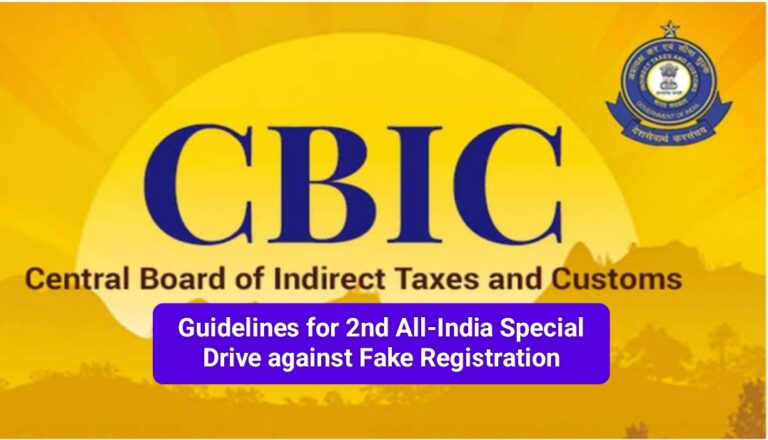CBIC Instruction Dated 12 August 2024: Guidelines for 2nd All-India Drive against Fake GST Registrations
The Central Board of Indirect Taxes & Customs (CBIC) has issued new guidelines in preparation for the second All-India drive against fake GST registrations, as outlined in the Instruction dated 12 August 2024. This follows the success of the first nationwide campaign, which ran from 16th May 2023 to 14th August 2023. That initiative was instrumental in identifying and eliminating fraudulent GST registrations, prompting the need for a follow-up effort to further cleanse the tax base and prevent revenue losses.
Key Highlights of the Guidelines
1. Second Special Drive Timeline
The upcoming All-India drive is scheduled from 16th August 2024 to 15th October 2024. The primary goal is to detect suspicious and fake GSTINs, conduct thorough verifications, and take necessary actions to eliminate these fraudulent entities from the GST system.
2. Identification of Suspicious GSTINs
GSTN, in collaboration with the Directorate General of Analytics and Risk Management (DGARM) and CBIC, will utilize advanced data analytics and risk parameters to identify high-risk GSTINs. The details of these suspicious entities will be shared jurisdiction-wise with the relevant Central and State tax authorities for further verification. Additionally, tax authorities may supplement this list through their own intelligence gathering and analysis using tools like BIFA, GAIN, ADVAIT, NIC Prime, and E-Way Bill Analytics.
3. Field Actions to be Undertaken
Upon receiving the list of suspicious GSTINs, jurisdictional tax officers must swiftly verify these entities. If a taxpayer is found to be non-existent or fictitious, immediate action should be taken to suspend and cancel their registration under Section 29 of the CGST Act. Furthermore, authorities are advised to consider blocking the input tax credit in the Electronic Credit Ledger as per Rule 86A of CGST Rules. Efforts will also be made to identify recipients who have wrongly availed input tax credit based on fraudulent invoices, with actions initiated for demand and recovery.
4. Coordination Across Jurisdictions
To facilitate seamless coordination, nodal officers will be appointed in each CGST Zone and State. These officers will be responsible for sharing information about suspicious GSTINs with their counterparts in other jurisdictions via the ‘Initiate Enquiry’ module on the GSTN Back Office portal.
5. Monitoring and Reporting
Weekly action-taken reports will be required from all States and CGST Zones. These reports, submitted by the designated nodal officers, will track the progress of verifications and actions taken against suspicious GSTINs. The GST Council Secretariat will compile these reports and share them with the National Coordination Committee, ensuring ongoing monitoring and feedback.
6. Identifying Masterminds and Beneficiaries
The guidelines also emphasize the importance of identifying the masterminds and beneficiaries behind these fake GST registrations. This includes taking action to recover government dues and, where necessary, provisionally attaching properties or bank accounts under Section 83 of the CGST Act.
Conclusion
The CBIC’s instruction underscores the government’s commitment to combating GST fraud through a coordinated and data-driven approach. The second All-India special drive against fake registrations is expected to be a significant step in ensuring the integrity of the GST system, protecting government revenue, and maintaining a fair business environment across the country.
To Access the official notification of the Instruction CLICK HERE
Also Read: GSTN Advisory on GSTR-1A: FAQs and Manual on Filing GSTR-1A
Read More
Odisha MFD Association Appeals to GST Commissioner for Penalty Relief
